This is part two of the Sunny Side Up series on solar hot water systems. For part one, please click HERE.
It seems like the engine is just getting warmed up as solar hot water systems stake their claim in the water heating market, both in residential and commercial applications.
Although relatively expensive and not consistently suitable for all sites and projects, solar hot water systems do provide various benefits, working to lower energy and resource costs, and reduce the carbon footprints of building.
However, these advantages seldom nullify the problem of design, with some architects and designers still unsure of where to incorporate these systems in an aesthetically pleasing way.
Is there no way then to harness clean, inexhaustible and free supplies of energy from the sun to heat water, but still achieve good design?
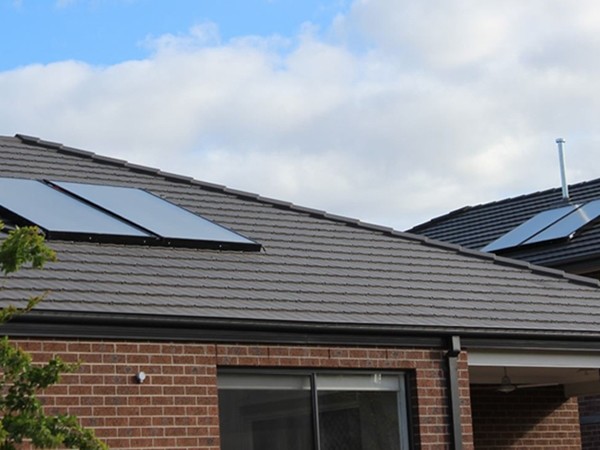
Chromagen solar hot water collectors
In parts of Australia, such as Darwin, solar water heaters have long been a part of the landscape.
“With the take up of solar PV panels for electricity, the rest of Australia seem to be accepting of solar collectors on the roof,” Rheem’s sales manager Tony Djodan says.
“Split systems and hi-line solar have now become the norm when choosing environmentally energy efficient domestic water heating.”
However, it is undeniable that a large storage tank can present an aesthetic obstacle.
“The visual effect of a large storage tank of a split system is a design challenge, especially if they have unsightly pipework and need to have air-flow around them, which means you cannot locate them internally,” says Robyn Gibson of Lifehouse Design.
“For this reason, we tend to use coupled systems, where the tank is on the roof. We are not so concerned with systems on the roof, as our building designs incorporate a flat or skillion-style roof, so the systems are less obvious.”
Alternatively, the firm will design slatted timber screens or some other surround to the ‘utility area’ that conceals the unsightly tanks and gas boost units.
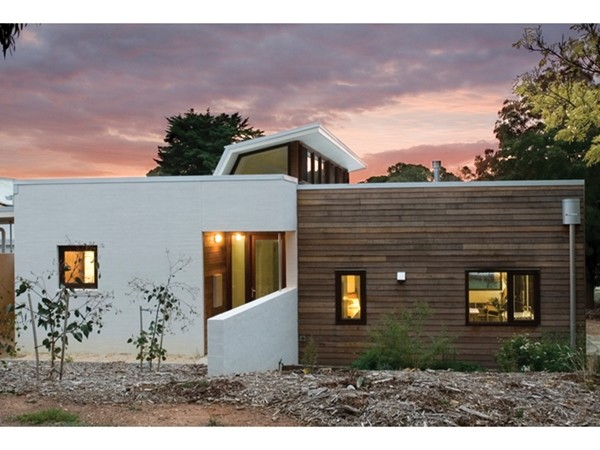
Fletcher Street House by Lifehouse Design features an Apricus evacuated tube system, although the tank is designed to be out of sight on the south side of the house. Photography by Rachel Pilgrim.
Design is not as big a problem in commercial applications, especially if the plant is installed on a high-rise structure, and therefore not in general view.
“Most solar collectors in commercial applications are installed on flat roofs. Most buildings have parapets surrounding the roof top which can hide the collectors from street level,” suggests Rheem’s technical marketing manager, David Micallef.
For split systems, Rheem supplies adjustable collector stands, which can be lowered to 15 degrees to reduce visual impact from the street level. However, the further away the collector is from the ideal inclination, the lower its performance.
An eco-friendly yet innovative and aesthetically pleasing product to take note of is the EcoHat, an environmental housing feature created by British architects Rogers Stirk Harbour & Partners.
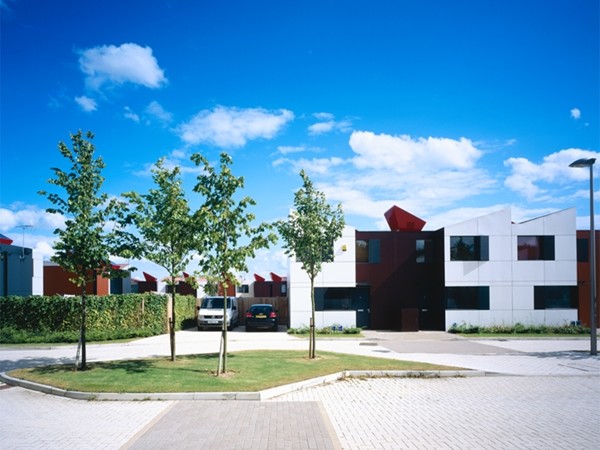
Oxley Woods Streetscape featuring the EcoHat. Image: Katsuhisa Kida
First used at the Oxley Woods development in England and perched atop the roofs or services spine of each of the 145 houses, the EcoHat is a powerhouse of energy efficiency. Essentially a red chimney, solar power heats the air as it enters through the EcoHat.
This warm air then passes through filters into the living space, or is used to heat water by means of a heat-transfer coil.
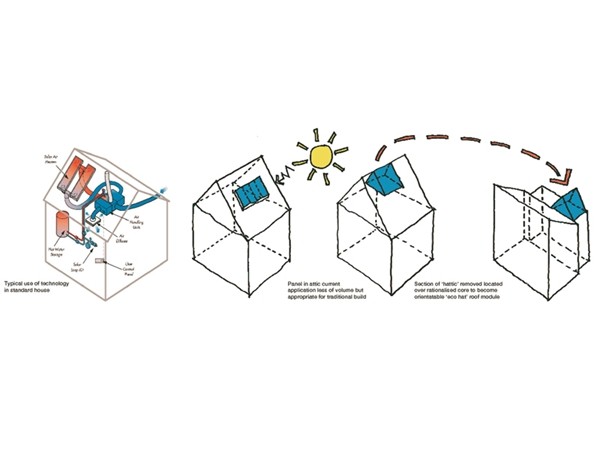
Concept of the eco hat. Image: Rogers Stirk Harbour + Partners
“We wanted to create something that meant we didn’t have to orientate the houses in order to maximise the energy we could gain from the sun,” says Andrew Partridge, project architect for Oxley Woods and the 8 Chifley building in Sydney.
The team, consisting of architects, service engineers and project manager, utilised a tried and tested system by Nuaire, which was adapted to the ‘hat’. Its casing conceals the gadgetry, while allowing the solar panels to be angled for maximum efficiency.
As a result, houses can be oriented in any direction, with the EcoHat always pointing to the appropriate direction for solar efficiency.
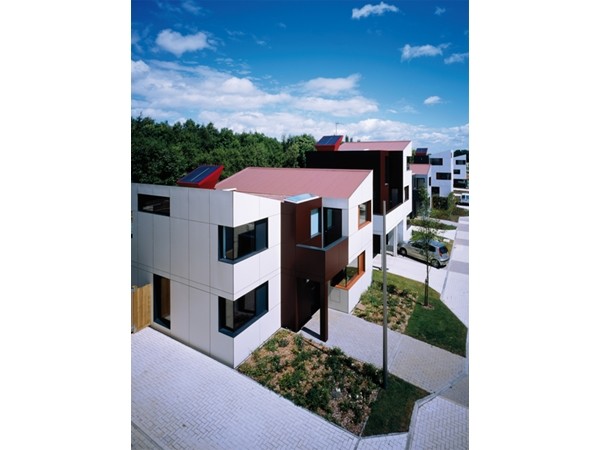
Streetscape of Oxley Woods by RSH+P. Image: Katsuhisa Kida
Allowing the residences to emit considerably less carbon dioxide than a conventional development of a similar size, this innovative product was created to resolve design issues at first, but ended up becoming a part of the design.
When asked how architects can ensure that their solar HWS is aesthetically pleasing, Partridge brings it back to the basics.
“It works best when such elements are considered from the start of the project, so they can be integrated into the design seamlessly,” he says.
“This ensures they do not end up either being the jarring element or prime mover.”
However, not all dwellings have suitable solar positions, and heat pumps present a good alternative. These pumps operate on a similar principle to refrigerators, and do not require roof panels, but rather absorb the atmospheric air to heat the water.
Lifehouse Design for instance has started specifying the Rinnai ‘26Eco’ instantaneous units for smaller projects where hot water use is minimal.
These units are highly efficient and do not have large amounts of hot water stored for long periods of time, Gibson says. They use approximately one third the energy of an electric water heater, while available rebates make them an economical option. However, they are a noisier system.
To ride the wave or not?
While there are currently no government regulations or codes for these systems, certain states require projects to have some sort of solar HWS. For instance, in Victoria, new homes must either have a solar HWS or plumbed rainwater tanks.
“But how effective are these regulations?” asks CSIRO Construction Systems Scientist, Michael Ambrose, adding that Solar HWS are often chosen over rainwater tanks because they are cheaper, and even then, cheaper systems that might not be the most effective are chosen over more expensive, useful ones.
With a minimum standard, the industry runs the risk of merely adding on these systems so as to complete a checklist.
Although solar HWS are expensive systems that are not easy to be included in all projects, they are effective systems that can make a difference to the built environment if architects incorporate them from the outset. This involves prioritising sustainability, and reconciling it with the other project elements, including cost and good design.
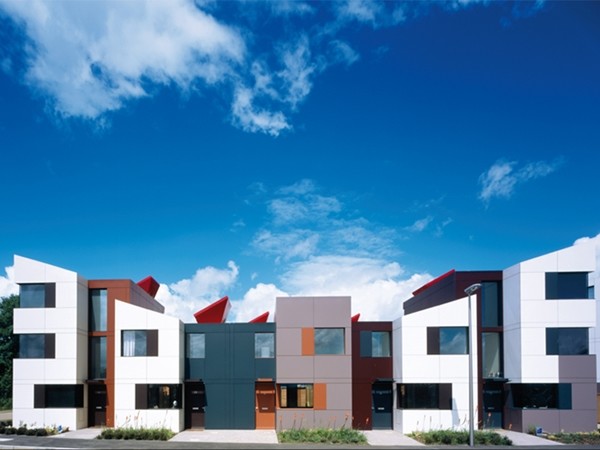
Streetscape at Oxley Woods. Image: Katsuhisa Kida

